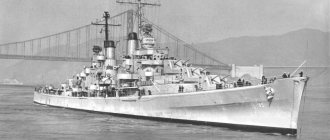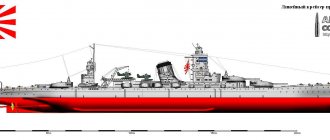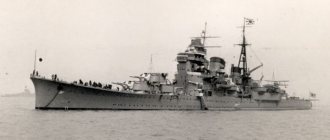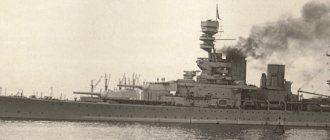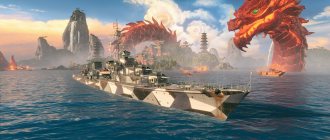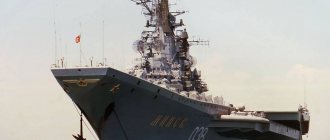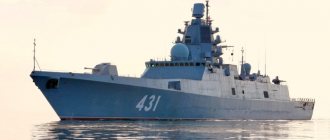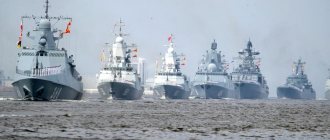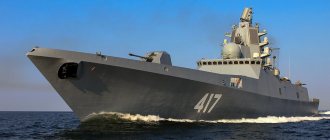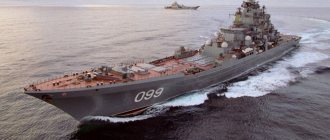Warships. Cruisers. The original pinnacle of Japanese excellence
The logical end to the conversation about the heavy cruisers of the Imperial Japanese Navy would be the story about the Tone-class cruisers.
In the material about the Mogami, the moment was touched upon when Japan used all the unspent displacement under the treaties to create 6 B-class cruisers. Four cruisers are just “Mogami”, and two... And two are our today’s heroes: “Tone” and “Tikuma”. The Mogami cruiser was taken as the basis for the design, but over time the project was very radically redesigned.
Initially, the mission included the same fifteen 155-mm guns with an elevation angle of 75° (which “if something happened” could be changed to 203-mm), eight 127-mm guns in twin mounts, twelve anti-aircraft guns, six 610-mm mm torpedo tubes on board, four seaplanes.
The armor protection is the same as that of the Mogami, that is, it should hold 203 mm shells in the cellar area and 155 mm shells in the power plant area. Maximum speed of 36 knots (1 less than that of the Mogami), cruising range of 10,000 nautical miles at 18 knots.
However, by the time they were ready, the ships were something completely different. All the alterations happened precisely when the first person of the project was not Fujimoto, but Fukuda, which I also already mentioned. It was easier for the admirals from the naval General Staff to put pressure on Fukuda, and the captain of the first rank tried to do everything that the gentlemen naval commanders wanted.
As a result, a completely different ship appeared outwardly. And not only externally, however, judge for yourself.
The main innovation: the number of main battery turrets was reduced by one, removing one turret from the stern altogether, and moving the second to the bow. This landmark decision allowed us to solve several old problems at once and create a couple of new ones at the same time.
The main thing was that the aft part of the cruiser was completely freed, where an airfield for 6 seaplanes was equipped (with catapults, of course), all aviation equipment from the middle part was moved to the stern.
At the same time, the air defense was strengthened with another pair of 127 mm guns.
Naturally, this still made the ship heavier, and therefore the cruising range was reduced to 8,000 miles.
The result was a “B” class cruiser, that is, a light cruiser, with twelve 155 mm guns and an air group of 6 seaplanes. A sort of scout. Naturally, with the prospect of replacing the 155 mm main caliber guns with 203 mm ones.
As I said above, the project had both pros and cons.
One of the advantages is that the concentration of all the main battery barrels in the bow should have definitely increased the accuracy of the salvo, reduced the dispersion of shells at long distances, and in general, as an artillery platform, the ship had become much more stable.
The advantages include the transfer of torpedo tubes to the stern, where they could easily cripple the ship if they were hit by enemy shells. In general, these torpedoes, which the Japanese admirals elevated to the rank of ideal, sometimes caused more harm to their own than to other people's ships.
In addition, the separation of aircraft and artillery at different ends of the ship prevented damage to one by the other. That is, obviously the planes would not have to suffer from the fire of the main caliber guns, as was the case when the planes were between the bow and stern towers.
Among the disadvantages, I would include the appearance of a dead zone when firing with the main caliber, especially during a retreat, and in general, the firing angle as a whole turned out to be very limited. Well, if a shell of 380 mm or higher had landed in the bow, this would obviously have been fraught with the loss of all the artillery.
Overall, it really turned out to be an interesting ship, a reconnaissance cruiser with a very decent range, not so much due to its range, but due to its air wing, which could conduct reconnaissance for almost 24 hours, replacing one aircraft with another as the crew refueled and rested.
So “Tone” in 1937, and “Tikuma” in 1938 became part of the Japanese Imperial Navy.
And, of course, as soon as Japan said “Goodbye, America!” and on January 1, 1937, withdrew from all maritime agreements, a plan was put into effect to rearm the Tone cruisers, as well as the Mogami, from 155 mm to 203 mm guns.
The ships became even heavier, the fifth pair of 127-mm universal guns was removed, but as compensation, the 13.2-mm machine guns were replaced by 25-mm twin machine guns.
We didn’t have time to make towers for all of them, so the conversion of the ships took a long time. But in the end, by 1940, both cruisers were ready and became part of the 8th Heavy Cruiser Division. The division consisted, in fact, of themselves. Tone was appointed as the flagship.
What were cruisers?
The displacement according to the project was 11,230 tons, the total, of course, jumped to 15,200 tons.
Length at the waterline is 198 m. Width at the waterline is 18.5 m. Draft 6.88 m when fully loaded.
Reservations: Armor belt: 18-100 mm (in the area of the power plant), 55-145 in the area of the cellars. Deck: 31-65 mm. Towers: 25 mm. Cutting: 40-130 mm.
Engines: 4 Kampon TZA, 8 Kampon Ro-Go boilers, 152,000 l. pp., 4 propellers. Speed 35.5 knots. Cruising range is 12,000 nautical miles at 14 knots or 8,000 miles at 18 knots.
Armament: Main caliber: 4 × 2 x 203 mm/50, ammunition 120 rounds per gun. Anti-aircraft artillery: 4 × 2 x 127 mm, 6 × 2 x 25 mm. Mine and torpedo armament: 12 (4 × 3) 610 mm torpedo tubes, ammunition capacity 24 torpedoes. Aviation group: 2 catapults type No. 2 model 5, 6-8 seaplanes.
The crew for the project was 874 people, but as air defense systems increased, it increased to 1000 people.
The main caliber was a masterpiece of creativity by Japanese designers! Three towers were placed in the usual “pyramid” pattern, but the fourth had to be literally shoved where there was room. As a result, the turret turned out to be turned backwards and seemed to be intended for firing backwards along the side. But the dead zone still turned out to be considerable, and the reconnaissance cruiser, in the worst case scenario, could only fight back with its torpedo tubes at the stern.
The guns were the same as on the Takao, the maximum firing range with the barrel elevated at 45 degrees was 29.4 km, the accuracy was very decent. It was believed that these guns could operate in barrage mode against flying targets, but in reality this was not practiced. Two rangefinder posts on turrets 2 and 4 with 8-meter rangefinders were responsible for pointing the guns. Later, a radar was connected to the control.
Anti-aircraft weapons were completely standard. Eight 127 mm Type 89 guns in twin mounts with shields. They were located on the sides of the chimney very close to each other. With a maximum elevation angle of 90°, their effective altitude reach reached 7400 meters. To control their fire, two SUAZO type 94 were used (on the sides of the superstructure), each with a 4.5-meter rangefinder. Ammunition totaled 200 unitary shots per gun.
Six twin 25-mm Type 96 machine guns were intended to fire at a distance of up to 3000 meters. Their ammunition consisted of 24,000 shells (2,000 per barrel).
In general, the air defense system of cruisers was constantly strengthened, and by mid-1944, the cruisers were armed with up to 60 25-mm units in various (from 1 to 3 barrels per installation) configurations. Plus, each ship received three radars, one “type 13” and two “type 22”, one of the “type 22” was used in the fire control system.
The torpedo armament was located at the stern. It is difficult to say how profitable this was, since torpedoes were a constant source of problems for Japanese ships. Together with airplanes, that is, aviation fuel, ammunition and bombs, the result was an explosive mixture in the literal sense of the word.
But 4 three-tube torpedo tubes were placed under the shelter deck (the hanging deck where the planes were stowed), two per side. Between the devices there were special ports for reloading torpedoes with taps.
The type 93 model 1 oxygen torpedoes used, with a launch weight of 2.7 tons, carried 490 kg of type 97 explosive and could travel 40 km at a speed of 36 knots, 32 km at 40 knots and 20 km at 48. Of the total ammunition load of 24, twelve The torpedoes were immediately in the torpedo tubes, and twelve more were in the rapid reloading system. The torpedo warheads were protected by an armor casing.
Aircraft. All the food was given to the undivided use of seaplanes, on which the Japanese naval command had high hopes. The planes were supposed to conduct reconnaissance, detecting enemy ships, primarily aircraft carriers. If possible, strike at them, illuminate targets at night using luminous aerial bombs.
According to the project, 6-8 seaplanes were to be based on the Tone: two three-seat Type 94 on catapult booms and four two-seat Type 95 on a rail system on the upper deck.
“Tikuma” was planned to be equipped with eight vehicles at once (four “Type 94” and four “Type 95”).
Each cruiser was equipped with two powder catapults located on the sides above the torpedo compartments and cranes for installing aircraft. It was possible to choose the type of aircraft that could be quickly lifted under the crane's boom and installed on a catapult.
In reality, in the first year of the war, both cruisers used 5 seaplanes, and then 4.
At various times, the cruisers were armed with the Aichi E13A type 0, Nakajima E8N type 95, Kawanishi E7K and Mitsubishi F1M. Air bombs (60 kg and 250 kg) were stored in an armored warehouse behind the 4th main battery tower, gasoline tanks (with a carbon dioxide filling system) were on the hold deck.
In principle, the unusual layout yielded results. Japanese designers managed not only to preserve the seaworthiness of the Mogami, but it turned out that the Tone was more stable than its predecessor.
At official tests in September 1938, "Tone" with a power of 152,189 hp. and a displacement of 14,097 tons showed a speed of 35.55 knots, and “Tikuma” in January 1939 at 152,915 hp. and 14,080 t - 35.44 knots.
The successful shape of the hull and the unusual layout of the ship allowed the Japanese to obtain a high-speed, maneuverable, stable ship with powerful, although not without drawbacks, weapons.
According to the project, the crew of the cruisers consisted of 874 people, but as small-caliber anti-aircraft artillery was strengthened during the war, the number of the entire crew exceeded 1000 people. However, even in this situation, the Tone were considered the most comfortable ships in terms of crew accommodation.
There were 4.4 cubic meters of living quarters per sailor, and 31.7 cubic meters per officer. m. Cabins and even sailor's quarters were equipped with bunks instead of outdated hanging ones. Ventilation was improved by installing centrifugal fans in living areas. The ships had pantries for rice and pickled foods (in the bow) and a freezer (in the stern); on the middle deck there was an infirmary, a sailor's bathhouse and sanitary and hygienic quarters for the command staff. Galleys for officers and sailors were located on the upper deck on the starboard side, near the forward torpedo compartment.
According to the memoirs of former officers of the Imperial Navy, Tone and Chikuma enjoyed the reputation of being the best Japanese cruisers in terms of habitability.
The construction of both cruisers was carried out in an atmosphere of heightened secrecy, which is why very few photographs of these ships have been preserved, despite the widespread love of the Japanese for their fleet.
Cruiser combat service
After commissioning, the cruisers Tone and Chikuma were assigned to the Yokosuka naval base and became part of the 6th Division of the 2nd Fleet, but soon the ships were transferred to the 8th Division of the same 2nd Fleet.
Before Japan entered World War II, both cruisers repeatedly took part in exercises, mainly in Chinese waters. Both cruisers took part in the campaign against Pearl Harbor; on December 8, seaplanes from the Tone and Chikuma carried out flights to assess the damage caused by carrier-based aircraft raids to the American fleet.
The cruisers then supported the landing on Wake Island. Having undergone scheduled repairs in Kure, both cruisers operated in the area of Rabaul, Palau Atoll, Banda Sea, their aircraft took part in a raid on the Australian port of Darwin.
As part of the Mobile Strike Fleet, consisting of cruisers, battleships and destroyers, Tone and Tikuma sank the American destroyer Idsall and the Dutch minelayer Modekerto on March 1, 1942.
On the morning of April 5, 1942, a seaplane from the cruiser Tone discovered the British heavy cruisers Cornwall and Devonshire in the waters of the Indian Ocean; both cruisers were then sunk by carrier-based aircraft from Japanese aircraft carriers.
The 8th Division, with both of its cruisers, took part in the invasion of Midway Atoll. On June 5, 1942, seaplanes of cruisers were searching for ships of the American fleet. Then a seaplane from the cruiser Tone discovered enemy aircraft carriers. In that memorable battle, the cruisers did not receive any damage, although they were not awarded victories.
Following the Battle of Midway, Tone and Tikuma took part in a campaign in the Aleutian Islands, and then returned to take part in the maneuvers of the 3rd Fleet in the Inland Sea.
In August 1942 - January 1943, Tone and Tikuma took part in the campaign in the Solomon Islands. During the Second Battle of the Solomon Sea on August 24, 1942, Tone coped with the task of rescuing the crew of the sunken aircraft carrier Ruidze. Seaplanes from the Chikuma discovered the location of the American fleet.
During the Battle of Santa Cruz on October 26, 1942, Chikuma was hit by a bomb dropped by an aircraft from the aircraft carrier Hornet. The bomb explosion seriously damaged the cruiser's superstructure and a fire started. The ship's experienced commander gave the crew the order to immediately send the torpedoes overboard so that they would not explode. The order was given on time and carried out extremely quickly: three minutes after the last torpedo was dropped overboard, the torpedo tube was hit by a 225-kg bomb dropped from another American carrier-based aircraft.
After repairs, both cruisers participated in the Tokyo Express, delivering cargo from Rabaul to Eniwetok, sometimes carrying out shelling of coastal targets.
On November 5, 1943, while in Rabaul, they were hit by American bombers. Both ships were damaged.
The 8th Cruiser Division was disbanded on January 1, 1944, and Tone and Chikuma became part of the 7th Mogami-class cruiser division.
On March 9, 1944, Tone and Chikuma operated together in the Indian Ocean. On that day, the cruiser Tone sank the British transport Behair off the coast of Cocos Island.
Both cruisers took part in the Battle of the Philippine Sea on June 19-20, 1944.
Battle of Leyte Gulf. Near Sama Island, Tikuma fired at the American light aircraft carrier Gambier Bay, but soon received a torpedo dropped from the Avenger torpedo bomber, which was based on the light aircraft carrier Netoma Bay. The torpedo made a hole in the side in the area of the boiler room, into which water began to flow. The cruiser lost speed. The Tikuma team moved aboard the destroyer Nowaki, after which Nowaki finished off the cruiser with native Japanese torpedoes. “Tikuma” sank on October 25, 1944. Soon, American aircraft sank the destroyer “Novaki”; no one from the destroyer’s crew and the Chikuma sailors on board the “Novaki” was saved.
The cruiser Tone was attacked by torpedo bombers, which were also supported by dive bombers. The raid took place on October 24, 1944, when the cruiser was sailing through the Sibuyan Sea and had not yet reached the San Bernardino Strait.
Three bombs hit the Tone, which, however, did not cause serious damage to the ship. After that attack, the Tone found itself next to the battleship Musashi.
The moment, to put it mildly, was not the best; a large group of American planes just flew into the battleship.
When the battleship was sunk, the Tone fought off the planes, but was soon hit by a 127-mm shell fired from the cannon of an American destroyer. Not God knows what, especially compared to Musashi.
Already at the end of the battle, a 250-kg bomb hit Tone. The damaged cruiser went to Brunei, and from there went to her home base of Maizuri, where she was put in dry dock for repairs and modernization.
During the renovation, the ship's anti-aircraft armament was strengthened to 62 automatic anti-aircraft guns of 25-mm caliber and instead of airspace surveillance radar No. 21, artillery fire control radar No. 22 was installed.
The repairs continued until February 1945, and after its completion, Tone never left Japan. The war at sea for Japan actually ended, and the last place of service of the cruiser Tone was the role of a training ship at the Naval Academy in Itayama.
On July 24, 1945, in Etajima, during a raid by American carrier-based aircraft, the Tone received three direct hits from 250-kg and 500-kg bombs and seven close explosions, as a result of which it lay on the ground and was abandoned by the crew. On July 28, he received additional damage during a new raid. Finally, “Tone” was raised and cut into metal in 1947-48.
What can we say as a result?
"Tone", like "Mogami", became the crown of design thought of Japanese shipbuilders. These were very remarkable ships in all respects, with good seaworthiness, powerful, albeit original, weapons, and, as practice has shown, quite durable.
But the main highlight was the ability to very quickly convert cruisers from light to heavy by replacing the three-gun 155 mm turrets with two-gun 203 mm ones.
After leaving the restrictive maritime agreements, the Japanese quickly carried out this operation on ships that had been built and were under construction. As a result, Japan had 18 heavy cruisers at the beginning of the war, just like the Americans.
In fact, it is not as simple as it seems: just rearrange the towers. It was truly just an unparalleled mixture of engineering and oriental cunning. So the Tone-class cruisers, together with the Mogs, are truly outstanding ships.
True, this did not help Japan at all in that war.
Design and construction[ | ]
Immediately after the adoption of the Third Fleet Expansion Program in June 1903 (it was planned to build 3 squadron battleships, 3 armored cruisers, 2 destroyers and a gunboat), the Imperial Japanese Navy began preparing an additional program. According to her project, it was initially planned to order 2 squadron battleships, 4 armored and 3 armored cruisers, 28 destroyers, 3 destroyers and 13 “special destroyers” (submarines). With changes (the number of armored cruisers was reduced to one, destroyers took the place of 3 destroyers), it was adopted after the start of the Russo-Japanese War at the 20th emergency session of the Japanese Diet (March 20-30, 1904) as a Wartime Warship Construction Program. The only armored cruiser received a temporary designation under the program - 2nd class cruiser “A”, but was not laid down until the end of hostilities[4].
The design of the 2nd class cruiser was carried out under the leadership of Captain 1st Rank Motoki Kondo from the third section of the Marine Technical Department (MTD). The basis was taken from the drawings of the Elswick armored cruiser Yoshino, purchased in Great Britain and included in the YaIF more than 10 years earlier, in 1894 (4150 tons, 109.73 × 14.22 × 5.18 m, speed 22.5 knots with a power of 15,750 hp, 4 152 mm and 8 120 mm guns). The final result, however, was quite far removed from the Yoshino (including in appearance, which became elegant thanks to the clipper stem, three chimneys instead of two, and beveled masts) and is considered the first cruiser project developed in Japan[5].
On September 30, 1905, the 2nd class "A" cruiser received the name "Tone" in honor of the river flowing through the Kanto Plain. It was laid down on the slipway of the Fleet Arsenal in Sasebo on November 27 of the same year. Previously, this shipyard was only engaged in the construction of destroyers with a displacement of up to 110 tons (“Tone” and 4,381-ton destroyers of the same program were the first large ships built at it), which, coupled with financial problems, led to a delay in construction that took resulting in more than 53 months. The cruiser was launched on November 27, 1907, underwent sea trials on April 13, 1910, and was transferred to the fleet on May 15 of the same year[6].
Links[edit]
- "Archival copy". Archived from the original on August 19, 2012. Retrieved 22 February 2013.CS1 maint: archived copy as title (link)
- Wildenberg, Thomas. "Midway: Pure Luck or Better Doctrine". Naval War College Review 58, no. 1 (winter 2005)
. pp. 121–135.
Books[edit]
- D'Albas, Andrieu (1965). Death of the Fleet: Japanese Naval Action in World War II
. Devin-Adair Pub. ISBN 0-8159-5302-X. - Boring, Paul S. (1978). Battle History of the Imperial Japanese Navy, 1941-1945. Annapolis, MD: Naval Institute Press. ISBN 0-87021-097-1.
- Howarth, Stephen (1983). Warships of the Rising Sun: The Drama of the Imperial Japanese Navy, 1895-1945
. Atheneum. ISBN 0-689-11402-8. - Jentsura, Hansgeorg (1976). Warships of the Imperial Japanese Navy, 1869-1945
. Annapolis: Naval Institute Press. ISBN 0-87021-893-X. - Lacroix, Eric; Wells II, Linton (1997). Japanese cruisers of the Pacific War
. Annapolis: Naval Institute Press. ISBN 0-87021-311-3. OCLC 21079856. - Whitley, M. J. (1995). Cruisers of World War II: An International Encyclopedia
. Annapolis: Naval Institute Press. ISBN 1-55750-141-6. - Miller, David (2004). "Page 244." An Illustrated Guide to Warships from 1860 to the Present Day
. London: Greenwich Editions, ISBN Salamander Books Ltd. 0-86288-677-5.
Service history[ | ]
"Tone" in Portsmouth in 1911.
"Tone" in 1918. After Tone entered service on July 15, 1910, she was assigned to the First Fleet. On December 1 of the same year, she, along with the armored cruiser Kurama, was transferred to the Second Fleet. Both of these ships, under the flag of the fleet commander, Vice Admiral Hayao Shimamura, left Yokosuka on April 1, 1911, bound for Europe. On June 24, they took part in the naval review in Spithead on the occasion of the coronation of George V, on the way back they passed through the Mediterranean Sea and returned to Japan on November 12, 1911.[10]
With the outbreak of World War I, the cruiser Tone, as the flagship of the 2nd Destroyer Flotilla of the 2nd Squadron of the United Fleet, took part in the siege of Qingdao.[13]
Since February 1916, he became part of the 3rd Squadron of the United Fleet, and based in Singapore, he was engaged in patrolling in the Indian Ocean.
From April 1, 1924 to January 31, 1925 and from December 1, 1925 to November 30, 1929, “Tone” served as a hospital on the Yangtze River in the Shanghai area. On November 30, 1929, the cruiser was transferred to the fourth category reserve and laid up in Sasebo[2].
On April 1, 1931, Tone was removed from the lists of the fleet, receiving the designation "Excluded Vessel No. 2" ("Hai Kan No. 2").[2] During exercises in April 1933, the former cruiser was used as a target for the heavy cruisers Aoba, Kinugasa and Kako, which were practicing the use of 200-mm semi-armor-piercing shells with new fuses. It was finally sunk by 30 kg naval fighter bombs on April 30[14].
Notes[ | ]
- ↑ 1234
Lacroix and Wells, 1997, p. 786. - ↑ 12345678910
Lacroix and Wells, 1997, p. 787. - ↑ 12
Lacroix and Wells, 1997, p. 788. - Lacroix and Wells, 1997, p. 1-2.
- Lacroix and Wells, 1997, p. 4-6.
- Lacroix and Wells, 1997, p. 2-4.
- Lacroix and Wells, 1997, p. 5-6, 787.
- Lacroix and Wells, 1997, p. 786-787.
- Lacroix and Wells, 1997, p. 6-7.
- ↑ 1234
Lacroix and Wells, 1997, p. 7. - ↑ 12
Lacroix and Wells, 1997, p. 5, 7. - Lacroix and Wells, 1997, p. 5,787.
- Isakov I. S. The Japanese operation against Qingdao in 1914. St. Petersburg: publisher Leonov M. A., 2002—176 p.
- Lacroix and Wells, 1997, p. 79.

